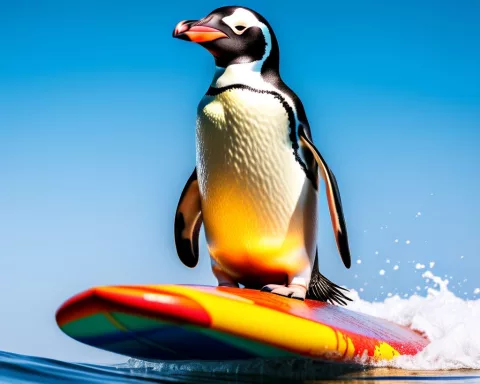Marine biologists have discovered a shift in the distribution of great white sharks in South Africa, with interactions between humans and sharks moving from the Western Cape to the Eastern Cape, hinting at a possible migratory pattern. The movements are influenced by various factors, including climate change and the predatory actions of killer whales. The findings highlight the need for intensified research efforts and effective conservation strategies to ensure the continued existence of these formidable predators.
Decoding the Mysterious Movements of South Africa’s Great White Sharks: Marine biologists have investigated the fluctuation and dispersal of great white shark populations across South Africa and discovered that while their protection has remained mostly unchanged since 1991, there has been a shift in distribution. The overall trend seems steady, but interactions between humans and sharks have moved from the Western Cape to the Eastern Cape, hinting at a possible migratory pattern. These movements are influenced by various factors, including climate change and the predatory actions of killer whales.
South Africa: A Home for Great White Sharks
South Africa’s Western Cape coast has long been recognized for its impressive congregation of great white sharks (Carcharodon carcharias). Their presence, whether for feeding, socializing, or resting, contributes significantly to the uniqueness and dynamism of the region’s marine ecosystem.
Of late, however, there has been a noticeable dip in the number of sightings of these magnificent creatures. Particularly alarming is the situation in the vibrant city of Cape Town, where the frequency of shark sightings has plummeted from over 300 across eight beaches in 2011 to zero since 2019. This drastic decline has triggered apprehensions about the conservation status of this pivotal species. As apex predators, their role in preserving equilibrium and vitality within marine food chains is indubitable.
Investigating the Enigma
Prompted by these concerns, marine biologists embarked on a comprehensive investigation into this matter. They employed a variety of data sources, including information from fellow scientists, tour operators, and shore anglers, to scrutinize the fluctuation and dispersal of great white shark populations across South Africa.
The findings of the research were captivating. Certain primary congregation sites exhibited troubling reductions, while others demonstrated increases or stability. Surprisingly, the overall trend seemed steady, implying that since their protection was established in 1991, the count of great white sharks has remained mostly unchanged.
Despite the apparent stability in numbers, a noteworthy shift in distribution was observed. Interactions between humans and sharks moved from the Western Cape to the Eastern Cape, hinting at a possible migratory pattern. This revelation presented a new assortment of challenges, including possible threats from fisheries and required alterations in beach management.
Unraveling the Mystery
Especially noteworthy was the change observed between 2015 and 2020. In Seal Island, False Bay (Western Cape), the rate of shark sightings declined from 2.5 per hour in 2005 to a mere 0.6 in 2017. Contrarily, Algoa Bay in the Eastern Cape reported a remarkable increase in the number of caught sharks, from six in 2013 to 59 in 2019.
The causes behind these movements are intricate and multifarious. Sharks, with lifespans exceeding 70 years, exhibit unique behaviors according to their life stages. Various factors such as water temperature, lunar phase, season, and food availability also impact their movement. Complicating the issue further are the effects of climate change and the predatory actions of killer whales.
Recent incidents have reported killer whales preying on great white sharks, developing a preference for their livers. These situations, first documented in 2015, coincide with significant behavioral modifications among the shark population.
Implications and Future Directions
The evolving spectrum of threats to great white sharks warrants serious attention. A recent study underscored the need to integrate data on shark movements with reliable capture records to evaluate potential dangers. There is a growing concern that as shark movements lean towards the east, the chance of them being caught might rise due to interaction with shark nets, drumlines, and gillnets.
This movement shift also influences human activities. Shark attacks, though infrequent, can significantly impact beach activities. Therefore, adjusting current management strategies and promoting public awareness about shark behavior might be essential steps.
Given these discoveries, it is paramount to intensify research efforts to better understand the factors influencing these elusive movements of these formidable predators. Additionally, initiating long-term monitoring programs, particularly along the Eastern Cape, is crucial. These initiatives will not only enhance our understanding of the changes in shark movements but also assist in devising effective conservation strategies.
In essence, the tale of South Africa’s great white sharks is an intriguing saga of resilience, adaptability, and survival in the face of challenges. These majestic marine creatures continue to survive and flourish despite the adversities they encounter. Their tale underscores the intricate and delicate balance of nature and our onus to ensure their continued existence.
1. What is the shift in distribution of great white sharks in South Africa?
Marine biologists have discovered that interactions between humans and sharks have moved from the Western Cape to the Eastern Cape, indicating a possible migratory pattern. This shift is influenced by various factors, including climate change and the predatory actions of killer whales.
2. Why are great white sharks important to South Africa’s marine ecosystem?
Great white sharks are apex predators, which means their role in preserving equilibrium and vitality within marine food chains is crucial. Their presence contributes significantly to the uniqueness and dynamism of the region’s marine ecosystem.
3. What is the current conservation status of great white sharks in South Africa?
Despite concerns about their conservation status, since their protection was established in 1991, the count of great white sharks has remained mostly unchanged. However, a noteworthy shift in distribution was observed, presenting new challenges such as possible threats from fisheries and required alterations in beach management.
4. What are the causes behind the movements of great white sharks?
Various factors such as water temperature, lunar phase, season, and food availability impact their movement. Additionally, effects of climate change and the predatory actions of killer whales have played a role in the recent changes in their distribution.
5. What are the potential threats to great white sharks in South Africa?
As shark movements lean towards the east, the chance of them being caught might rise due to interaction with shark nets, drumlines, and gillnets. Shark attacks, though infrequent, can significantly impact beach activities.
6. What steps can be taken to ensure the conservation of great white sharks?
Initiating long-term monitoring programs, particularly along the Eastern Cape, is crucial to enhance our understanding of the changes in shark movements. Additionally, adjusting current management strategies and promoting public awareness about shark behavior might be essential steps to ensure their continued existence.












